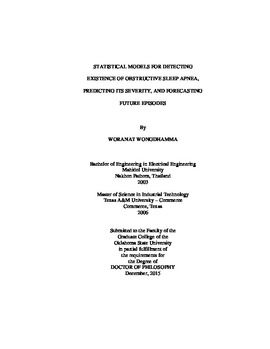| dc.contributor.advisor | Heragu, Sunderesh | |
| dc.contributor.author | Wongdhamma, Woranat | |
| dc.date.accessioned | 2016-09-29T18:47:11Z | |
| dc.date.available | 2016-09-29T18:47:11Z | |
| dc.date.issued | 2015-12 | |
| dc.identifier.uri | https://hdl.handle.net/11244/45388 | |
| dc.description.abstract | This dissertation presents three statistical models based on data mining and nonlinear time-series analysis techniques as an alternative method for the diagnosis and treatment of obstructive sleep apnea disease (OSA). From a diagnosis perspective, our method reduces the time and cost associated with the conventional method by first screening a non-OSA subject from the population, then individually determining the OSA's severity by utilizing the data from a single-lead electrocardiogram (ECG) device that is worn overnight at the subject's location. Our OSA forecasting model can be used to activate an OSA therapy device such as a continuous positive airway pressure (CPAP) machine or a hypoglossal nerve stimulator (HNS) as needed or before an OSA episode so that the latter can be averted in real time. | |
| dc.description.abstract | In particular, our contributions are: | |
| dc.description.abstract | 1) Detect the existence of OSA in an individual based on the pattern of biological physiology and simple clinical data with a low false negative rate and reasonable accuracy (FNR: 5.3%, Accuracy: 84.47%). People with some degree of probability of having OSA will be confirmed by the next model. | |
| dc.description.abstract | 2) Determine the OSA severity by classifying the OSA episode (event) from one-lead ECG data collected overnight (accuracy: 92.26% with 10,052 equally sampled events from 24 subjects). The advantage of our model is that the variations (i.e., different body build, age, gender, activity, health conditions, and race) have very little effect on the prediction because the neighboring patterns in the reconstructed phase spaces have very little or no correlation to those variations. This benefit can be seen from our model's performance compared to two other models that exist in the literature. | |
| dc.description.abstract | 3) Forecast an incoming OSA episode in real time using the one-lead ECG data (accuracy: 92%, 88%, and 87% for 1, 5, and 10 minutes ahead). This forecasting model with any appropriate OSA episode prevention device (i.e., HNS, and just-in-time CPAP) will allow for an effective OSA treatment method for CPAP nonadherence OSA sufferers. | |
| dc.description.abstract | 4) Develop a wearable device that can collect the biological data via a single-lead ECG as a home sleep test (HST) device. | |
| dc.format | application/pdf | |
| dc.language | en_US | |
| dc.rights | Copyright is held by the author who has granted the Oklahoma State University Library the non-exclusive right to share this material in its institutional repository. Contact Digital Library Services at lib-dls@okstate.edu or 405-744-9161 for the permission policy on the use, reproduction or distribution of this material. | |
| dc.title | Statistical models for detecting existence of obstructive sleep apnea, predicting its severity, and forecasting future episodes | |
| dc.contributor.committeeMember | Kolarik, William | |
| dc.contributor.committeeMember | Liu, Tieming | |
| dc.contributor.committeeMember | Madihally, Sundar | |
| osu.filename | Wongdhamma_okstate_0664D_14332.pdf | |
| osu.accesstype | Open Access | |
| dc.type.genre | Dissertation | |
| dc.type.material | Text | |
| thesis.degree.discipline | Industrial Engineering and Management | |
| thesis.degree.grantor | Oklahoma State University | |
